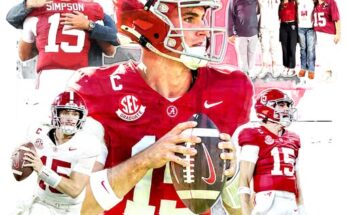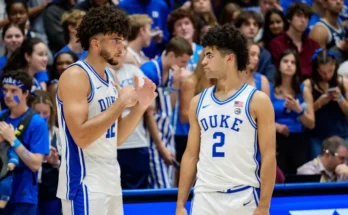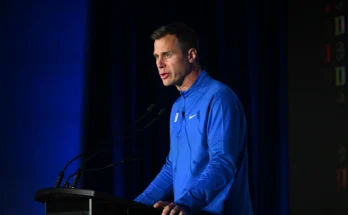The Impact of Terron Armstead’s Retirement on the Miami Dolphins, the Patrick Paul Era, and Other Topics
Terron Armstead’s decision to retire from the NFL has created a seismic shift for the Miami Dolphins. After a decorated 11-year career—highlighted by five Pro Bowl selections and a long-standing reputation as one of the league’s most technically sound and respected left tackles—Armstead leaves behind a legacy of toughness, mentorship, and consistency. But in his absence, the Dolphins face a series of urgent questions and opportunities. Chief among them: Is rookie Patrick Paul ready to step into one of the most important positions on the team?
The news of Armstead’s retirement didn’t necessarily come as a surprise. At 33 years old, he had battled through numerous injuries throughout his career. From knees to pectoral strains to nagging hip issues, Armstead frequently played through pain. Yet his leadership on the field and in the locker room never wavered. Now, with his departure, the Dolphins must navigate a pivotal transition as they try to maintain momentum in a highly competitive AFC East.
Terron Armstead’s Miami Legacy
Though he spent the majority of his career with the New Orleans Saints, Armstead’s impact in Miami was immediate and enduring. Signing with the Dolphins in 2022, he brought professionalism and polish to an offensive line that had been one of the team’s biggest weaknesses. Miami was desperate to protect quarterback Tua Tagovailoa, and Armstead was the centerpiece of that solution.
In two years with the Dolphins, Armstead helped stabilize the line and improve pass protection. His arrival coincided with Tua’s breakout and the team’s offensive renaissance under Mike McDaniel. More than just his on-field performance, Armstead served as a mentor to young linemen and a vocal leader in the locker room. His approach to preparation, film study, and technique left a lasting impression on players and coaches alike.
Immediate Fallout: Offensive Line Concerns Resurface
Armstead’s retirement leaves a gaping hole at the most critical position on the offensive line. The Dolphins had structured much of their protection schemes around his presence, giving Tua the security he needed to operate in a timing-based, RPO-heavy offense. Without Armstead, that safety net is gone, and the left side of the line becomes a major question mark.
While Miami has invested heavily in surrounding Tua with skill-position talent, the foundation of any offense lies in the trenches. The retirement forces the Dolphins to revisit their offensive line philosophy and, more urgently, determine whether they have an in-house replacement who can be trusted immediately.
Enter Patrick Paul.
The Patrick Paul Era Begins
At 6-foot-7 and over 330 pounds, Patrick Paul has all the physical traits of a future franchise left tackle. Drafted out of the University of Houston, Paul was seen as a developmental prospect with a high ceiling. The original plan may have been to bring him along slowly under the tutelage of Armstead. But with Armstead gone, the timeline has accelerated dramatically.
The Dolphins’ coaching staff believes in Paul’s potential. A two-time All-AAC performer with 44 collegiate starts under his belt, he possesses strong hands, long arms, and excellent movement skills for his size. Scouts praised his pass-blocking technique and his ability to mirror defenders on the edge. However, like many rookie tackles, Paul will face a steep learning curve transitioning to the NFL.
His success will depend not only on physical ability but also on his ability to absorb coaching, handle the mental responsibilities of protecting a left-handed quarterback’s blind side, and learn to process complex defensive looks in real time.
Supporting Cast and Line Cohesion
Patrick Paul won’t have to do it alone. The Dolphins return several key starters on the offensive line, including right tackle Austin Jackson, center Connor Williams (pending contract talks), and right guard Robert Hunt. This group, while not elite, showed flashes of cohesion and dominance in 2024, especially in the run game.
Still, the left tackle position is the anchor. If Paul falters early, the team may have to reshuffle the line or dip into free agency for veteran insurance. That would be far from ideal, especially for a team with playoff aspirations. But for now, the job is Paul’s to lose.
Protecting Tua: A Franchise Priority
Tua Tagovailoa’s health is the top priority for the Dolphins. The franchise has invested in him not only financially but structurally. The offense is tailored to his strengths: quick decision-making, timing routes, and exploiting the middle of the field. That style of play demands precise, consistent protection—especially from the left tackle, as Tua throws left-handed.
Armstead’s retirement heightens the risk for Tua. One wrong hit from the blind side can derail a season—or a career. This puts enormous pressure on Patrick Paul to not only develop but to perform at a high level from Week 1. The Dolphins may need to adjust their protections or game plans to give him help early, such as chip blocks from tight ends or more motion to freeze edge rushers.
Locker Room Void and New Leadership
Armstead wasn’t just a great player—he was a respected voice in the locker room. His departure leaves a void in leadership, particularly among the offensive line group. Who steps up to fill that space?
Austin Jackson, now entering his fifth NFL season, may take on a larger leadership role. So could Robert Hunt, assuming the team brings him back on a long-term deal. There’s also the possibility of a new voice emerging—perhaps even Patrick Paul, who may grow into that role as he gains experience.
Veteran voices across the roster, such as wide receiver Tyreek Hill and defensive tackle Christian Wilkins, will also be critical in maintaining the locker room’s competitive, unified identity.
The Bigger Picture: Super Bowl Window and AFC Contention
The Dolphins are no longer just a fun team with flashy weapons. They’re expected to contend. The 2025 season may be one of the most pivotal years in franchise history. The defense, now fortified with young pass rushers and veteran savvy, is playoff-ready. The offense is explosive when Tua is protected. But without a reliable offensive line—specifically at left tackle—the entire machine could sputter.
In an AFC loaded with quarterback talent—Patrick Mahomes, Josh Allen, Joe Burrow, Lamar Jackson, and now Caleb Williams—the margin for error is razor thin. Protecting Tua and keeping him upright in shootouts is non-negotiable. Armstead’s retirement doesn’t change the expectations. It only raises the stakes.
Cap Space and Free Agency Moves
From a financial standpoint, Armstead’s departure gives the Dolphins some breathing room. Depending on how the retirement is structured, they may gain additional cap space that could be used to reinforce the offensive line, add depth to the defense, or renegotiate deals with key veterans.
If Patrick Paul struggles in the preseason, the front office could look at available free agents or trade options. There are always a few veteran linemen on the market looking for a playoff contender. Names like Donovan Smith or David Bakhtiari (if healthy) could be stopgap options. But make no mistake—Miami wants Paul to succeed.
Draft Strategy and Future Outlook
Terron Armstead’s retirement will also affect how the Dolphins approach future drafts. Offensive line, particularly tackle depth, will likely remain a top priority for the foreseeable future. Miami’s front office has done a solid job of drafting defensive playmakers, but building depth across the offensive line has to be next.
Expect the team to continue investing in developmental linemen and possibly doubling down if Patrick Paul shows growing pains. Even if Paul becomes a long-term answer, adding a swing tackle or grooming a future right tackle would be wise.
A Pivotal Crossroads for the Dolphins
Terron Armstead’s retirement marks the end of a crucial era for the Miami Dolphins—a time when the offensive line began to catch up with the rest of a high-octane roster. In many ways, Armstead’s presence helped bridge the gap between chaos and structure, inconsistency and belief.
Now, the baton has been passed. Patrick Paul, still unproven at the NFL level, has a golden opportunity to make the position his own. The Dolphins will rally around him, but the pressure will be immense. Tua’s health, the offensive rhythm, and even Miami’s playoff hopes may hinge on how quickly Paul matures into the role.
From New Orleans to Miami, Terron Armstead was the consummate professional. He gave the Dolphins exactly what they needed when they needed it most. His retirement creates questions—but it also creates opportunities. The future of Miami’s offensive line, and perhaps its championship ambitions, now rests on the shoulders of a promising rookie ready to make his mark.



